Curriculum Vitae
Download CV
Link to download a short CV in pdf format: here.
Table of Contents
Projects
Project CELTIC: Continuous Embedded LES for Turbulent flows in Industrial Configurations
| Co-ordinator | Project page | Funded by | Industrial partners | Computing resources |
|---|---|---|---|---|
| Rémi Manceau | CELTIC | 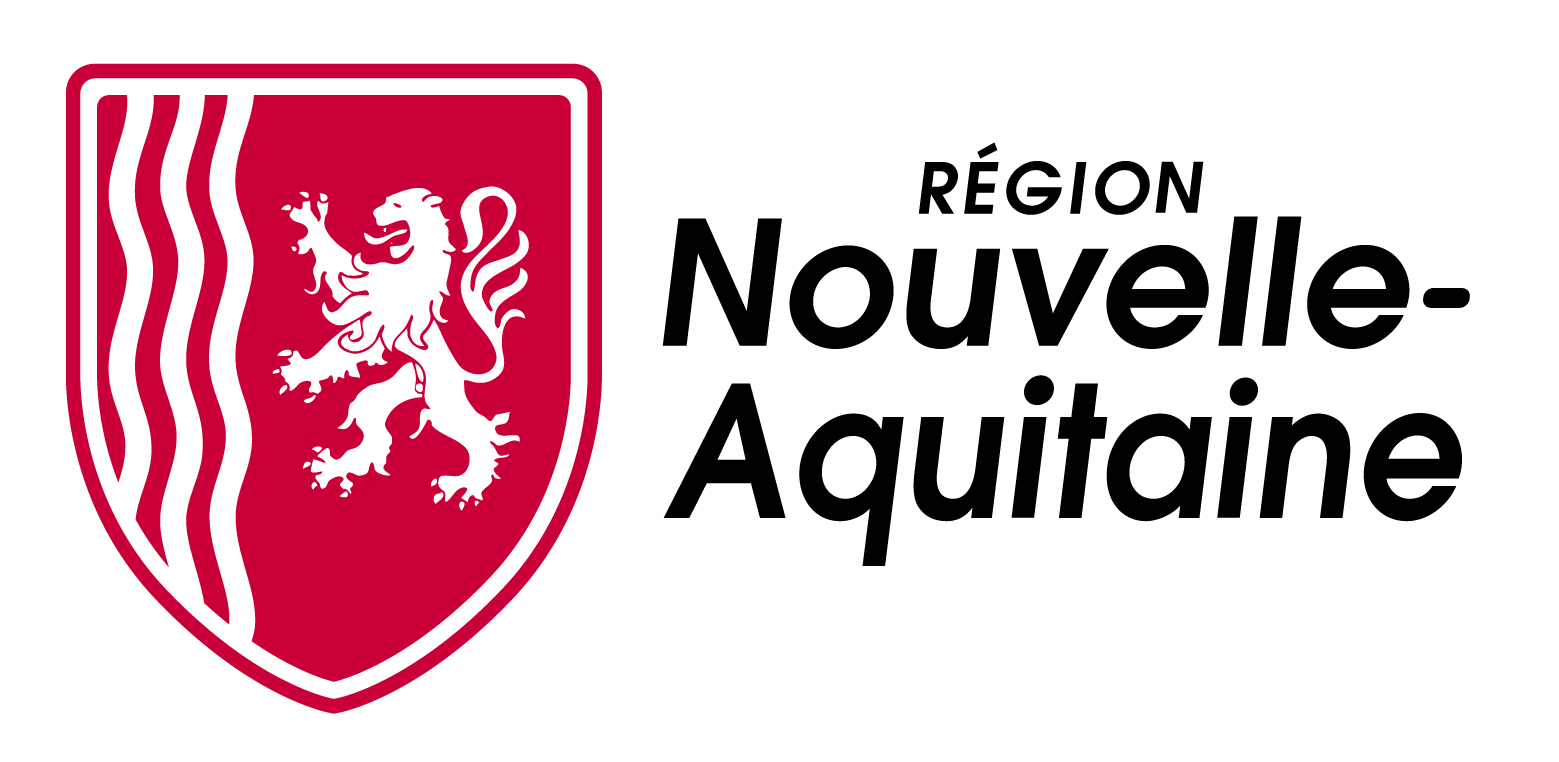 |
 |
CiNES Adastra  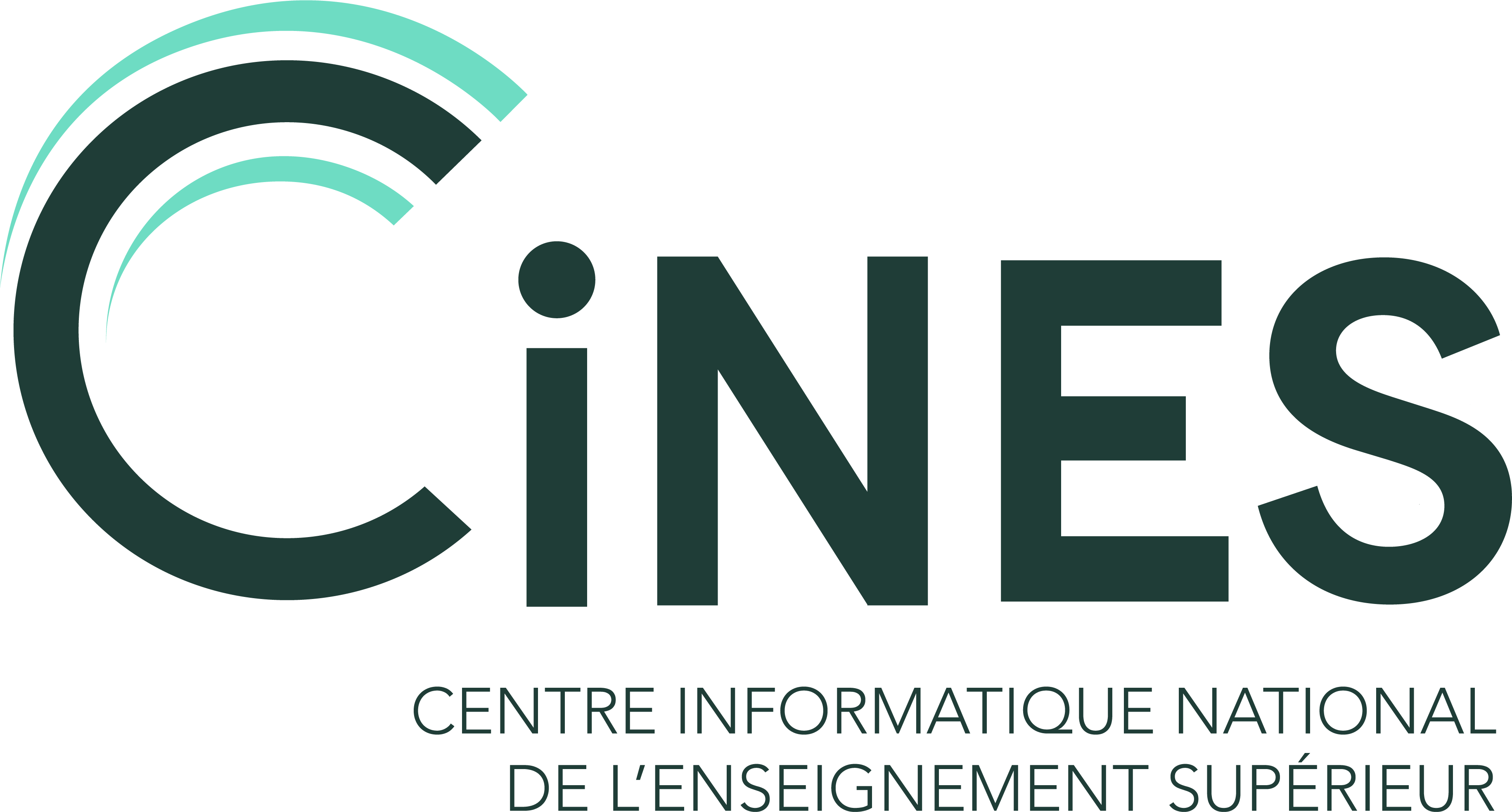 |
Advancements in the available computation power has vastly improved the resolution of length/time scales in numerical simulations of turbulent fluid flows (CFD). Despite this fact, the reality is that high-fidelity LES is still uncommon in industrial and environmental applications while usage of RANS remains extensive. The multi-scale multi-resolution approaches such as hybrid RANS/LES methods are aimed at bridging this gap such that the computational cost is drastically reduced while retaining the capability to resolve unsteady motions in critical regions of interest. Furthermore, embedded LES approaches are of particular interest where a LES region is surrounded by RANS regions which is a specific application of the zonal hybrid RANS/LES method hence allowing for a further reduction in computational cost. Zonal methods imply a pre-defined and purely discontinuous RANS-LES interface resulting in a strong RANS/LES coupling necessitating proper inflow conditions for the LES region in addition to limiting the model's ability to adapt based on physical criteria determined during the calculation.
In this work, the aim is to develop a novel strategy for embedded LES in the context of continuous approaches, called continuous embedded LES (CELES), wherein the interface between RANS and LES is controlled by a continuous function related to the flow parameters. A continuous interface leads to a grey-area where the model is neither in RANS mode nor LES mode entirely. In particular the RANS-to-LES transition leads to an underestimation of the total stresses at the inlet of the LES region which should be compensated for by an addition of synthetic turbulence in order to avoid a degradation of the results. In this context, the global hybrid RANS/LES model called HTLES (Hybrid Temporal LES) is augmented using an active approach such that a volumetric force is added to the momentum equation to aid in the development of unsteady motions in the RANS/LES interface. The Active HTLES model is thus indispensable for the development of a CELES approach.
In order to evaluate the approach, a fully turbulent unsteady flow over a surface-mounted cube is simulated and compared with experimental data of Martinuzzi and Tropea (1993). The experimental measurements are made using LDA techniques at a Reynolds number, based on the cube height, of \(Re_{H} = 40000\). The test case exhibits interesting physics such as coherent vortex structures upstream of the cube and in the symmetry plane around the cube, vortex shedding in the cube wake, and recirculation zones. This bodes well as an evaluation case for the continuous embedded LES approach whereby different strategies can be tested for the placement of the LES region within the solution domain.
As a first step in the process, a fully turbulent periodic channel is computed at a bulk Reynolds number based on the half channel height of \(Re_{B} = 40000\) to generate inlet conditions for the proceeding simulations of the surface-mounted case. Unsteady RANS computations are carried out to establish a base case to compare with the experimental data and as a kick-off point for the use of a hybrid RANS/LES model. The URANS simulations are capable of capturing the global physics of the flow, however, they lack in the correct prediction of the reattachment points. The HTLES model is then computed so as to evaluate the ability of the model to capture unsteady phenomena. As a final step, the Active HTLES approach is tested which involves the calibration of the RANS-LES interfaces.
Project MONACO_2025: MOdelling NAtural COnvection 2025
| Co-ordinator | Project page | Funded by | Industrial partners | Computing resources |
|---|---|---|---|---|
| Rémi Manceau | MONACO_2025 |  |
  |
IDRIS Jean Zay   |
Doctoral research thesis: Modelling turbulent flows in the natural convection regime using hybrid RANS-LES approaches (HAL)
The MONACO_2025 project is devoted to the development and validation of turbulence models for natural convection flows. Flows driven solely by buoyancy effects, i.e., density variations occurring in the fluid medium caused by the presence of temperature gradients, are termed as /natural convection flows/. Buoyancy affected flows play an important role in many industrial and environmental applications, for instance, in the sectors of the two industrial partners; EDF: for the design of nuclear power plants and Stellantis: for the design of under-hood space of auto-mobiles. In order to avoid expensive experiments and promote rapid design and development, it is quintessential to employ efficient, robust, and accurate CFD models to simulate such flows. The thesis represents the conclusion of the project MONACO_2025 aimed at developing a range of turbulence models accounting for buoyancy.
Research and development in the industrial context is still dominated by the use of RANS models, in particular the use of first order eddy-viscosity models thanks to their affordability. To that end, the first part of model developments are focussed on the RANS strategy. Building up on the buoyancy sensitised eddy-viscosity model (Full buoyancy extension (FBE)) previously developed as part of the MONACO_2025 project, the performance of these models is assessed in industry relevant test case such as that of natural convection in a square differentially heated cavity (DHC) at a high Rayleigh number of \(10^{11}\). Two models are assessed, namely the \(k \omega\)-SST and BL-\(v^{2}/k\), which are highly relevant to the industrial sector. The buoyancy sensitised RANS models, initially developed in the vertical differentially heated channel flow show significant improvements in the prediction of the mean velocity profiles thanks to the improved momentum balance. In the case of square DHC, where the simulations are in URANS mode due to the presence of resolved motion even in refined grids, the improvements are marginal but consistent. A particular attention is paid to the formulation of the source terms in the specific dissipation rate equation, \(\omega\), of the \(k \omega\)-SST model when considering the effects of stratification. The reformulation leads to a correction in the behaviour of turbulent viscosity in the stratified core region of the square DHC.
An important objective of the MONACO_2025 project is the development of models able to predict time-dependent phenomena. In this regards, hybrid RANS/LES models offer a cost-effective simulation strategy while retaining the ability to capture the necessary unsteady flow information. As such, the second part of the thesis focusses on the extension of the HTLES (Hybrid Temporal Large Eddy Simulation) model previously developed for isothermal flows to natural convection flows. The \(k \omega\)-SST HTLES model is sensitised to buoyancy effects through the implementation of the FBE to aid the underlying RANS model. The behaviour of the model is assessed in the square DHC leading to the development of a new shielding function called the elliptic shielding function aimed at making the model more robust and reduce the influence of empiricism. Interestingly enough, although the improvements from the FBE are marginal, these improvements are retained when incorporated in the HTLES model as compared to the HTLES model with a standard eddy-viscosity closure. Finally, the RANS and HTLES models are compared against high-fidelity LES simulations to showcase the potential of the HTLES method in the prediction of time-dependent phenomena while keeping the computational costs low.
Other research experiences
Master thesis: Numerical simulation of pulse-tube cryocoolers
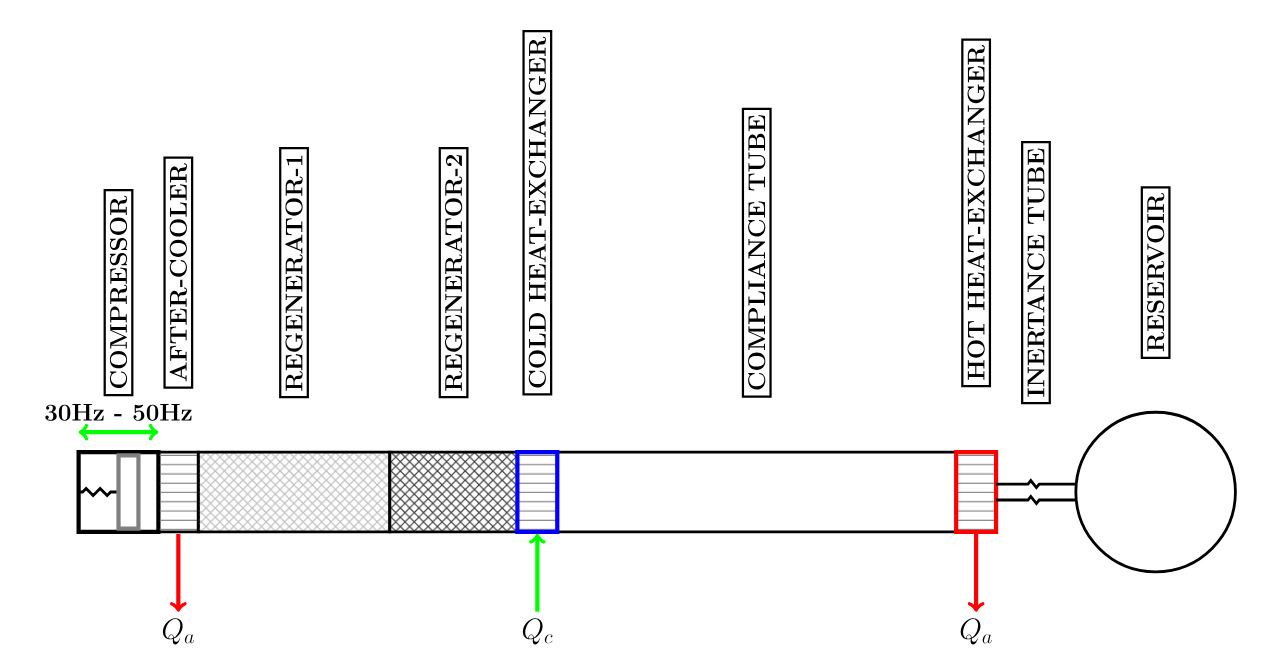
Figure 1: Schematic of an Inertence Pulse-tube Cryocooler
This thesis entails the use of a numerical simulation tool called Sage in an attempt to model a realistic, non-ideal Pulse-tube Cryocooler. The work starts from gaining a basic understanding of cryocoolers, in particular the Stirling-type Pulse-tube cryocooler, to a deeper understanding of the thermodynamics and the underlying physics. With the aim of developing a model using the numerical simulation tool, Sage, a brief review of the tool is carried out to understand it’s inner workings. A model of 50K pulse-tube cryocooler is successfully simulated and the results are analyzed. Efforts are made to evaluate the tool by comparing the simulation results with Experimental and Analytical data. Specific behavioural patterns of the pulse-tube cryocooler are extracted through parametric analysis. A particular effort is made at understanding the phase shifting effects of the inertance tube.
Academic project: Influence of large-scale structures in the near wall region of a channel flow
The purpose of this work was to study the influence of large scale structures on the near wall region of a Channel flow using Spectral analysis & Amplitude Modulation techniques. The data was obtained from DNS/LES simulations. Briefly, the core idea is that the large scales exert an influence on the small scales and by studying the correlation between the large scale signal and that of an envelope (modulating component) of the small scale signal, this influence can be detected by the appearance of a secondary peak around \(y^{+} \approx 100\) at higher reynolds numbers.
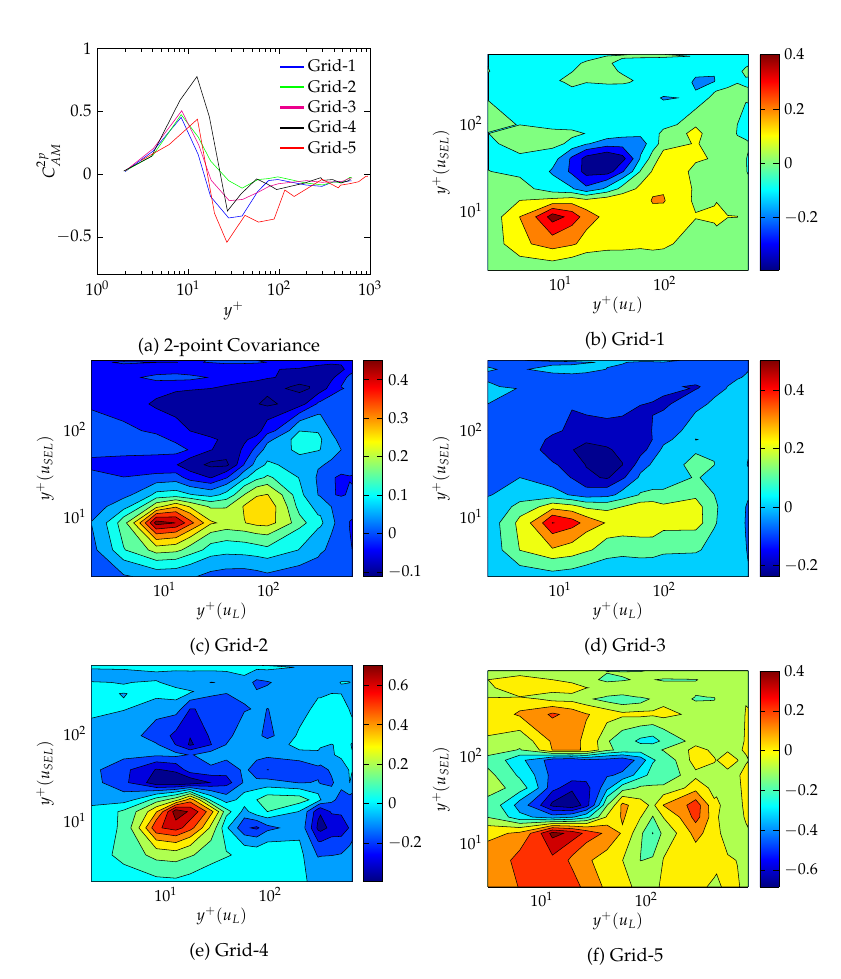
Figure 2: Covariance \(C = \overline{u_{L}^{+} u_{sEL}^{+}}\) with a pass-band filter for separating the scales showing the amplitude modulation effects of the large scales on the small scales. \(Re_{\tau} = 650\)(Grid − 1); \(Re_{\tau} = 650\)(Grid − 2); \(Re_{\tau} = 659\)(Grid − 3); \(Re_{\tau} = 630\)(Grid − 4); \(Re_{\tau} = 982\)(Grid − 5). \(u_{L}\) is the large scale component and \(u_{sEL}\) is the large scale component of the small scale envelope.
Research internship: Study of the near-wall coherent structures in a zero pressure-gradient turbulent boundary layer
The purpose of this work was to detect & characterise near-wall large scale coherent structures using Spectral analysis & Image-processing techniques to study their impact on near-wall turbulence statistics in a DNS simulation of a Zero-Pressure gradient Turbulent boundary layer. The large scale structures are studied using mathematical morphology techniques such as the Opening operation shown in the figure below.
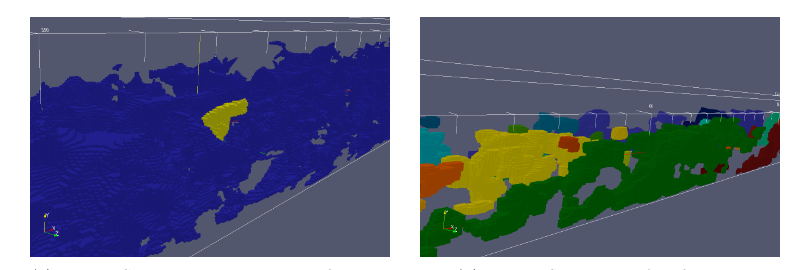
Figure 3: LEFT: labelled structures before an Opening operation; RIGHT: labelled structures after an Opening operation
Gas Turbine Research Establishment (GTRE)
Work package engineer
- Heat transfer analysis of an annular combustion chamber using ANSYS.
- CFD analysis of a V-gutter Flame holder to find an optimal cooling configuration. (ANSYS Fluent)
- CFD analysis of internal cooling channels of Turbine blades aimed at increasing blade life. (ANSYS Fluent)
Graduate apprentice trainee
- Training in Gas turbine engine assembly procedures & Quality standards.
- Training in Engineering design practices followed in research at GTRE & Computer Aided Engineering (CAE) tools.
Conferences
Speaker
- Puneeth Bikkanahally, Remi Manceau. Modelling turbulent flows in the natural convection regime using hybrid RANS-LES approaches. 17th ERCOFTAC SIG15/MONACO2025 workshop: Turbulent natural convection flows in differentially heated cavities, Jan 2023, Pau, France. (link)
- Puneeth Bikkanahally. Modélisation des écoulements turbulents en régime de convection naturelle par approches hybrides RANS-LES. Journées de l’Ecole Doctorale Sciences Exactes et leurs Applications (ED-SEA), Université de Pau et des Pays de l'Adour (UPPA), Jul 2021, Pau, France. (link)
- Puneeth Bikkanahally, Remi Manceau, Franck Mastrippolito. Development of a hybrid RANS-LES model based on temporal filtering for natural convection flows. WCCM - 14th World Congress in Computational Mechanics, ECCOMAS Congress 2020, Jan 2021, Virtual, France. (link)
- Puneeth Bikkanahally, Remi Manceau. Modelling turbulent flows in the natural convection regime using hybrid RANS-LES approaches. jspyrene2020 : Journée Scientifique autour du cluster Pyrene et autres moyens de calcul 2020, Oct 2020, Pau, France. (link)
Co-author
- Remi Manceau, Mahitosh Mehta, Martin David, Puneeth Bikkanahally. Generation of turbulent structures for CELES (continuous embedded LES). A turbulence day in celebration of the career of Jean-Paul Bonnet, Institute PPrime, Jun 2024, Poitiers, France. (link)
- Sofen Kumar Jena, Puneeth Bikkanahally, Remi Manceau. Numerical simulation of a turbulent natural convection flow in a cubic cavity with centrally placed partially heated inner obstacle. 3rd high-fidelity industrial LES/DNS symp. (HiFiLeD), Dec 2022, Brussels, Belgium. (link)
- Remi Manceau, Puneeth Bikkanahally. Hybrid Temporal LES: from theory to applications. HiFiLeD - 2nd High Fidelity Industrial LES/DNS Symposium, Sep 2021, Toulouse / Virtual, France. (link)



